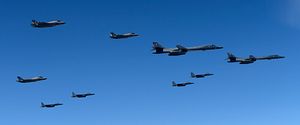On Sunday, the United States, along with South Korea and then Japan, staged multiple shows of force over the Korean peninsula.
The maneuvers came in response to North Korea’s launch of a ballistic missile over Japan on September 15.
That missile was North Korea’s best-performing ballistic missile test to date, demonstrating a range capability of 3,700 kilometers–a distance sufficient to strike Guam.
The demonstration on Sunday involved aerial assets from the U.S. Air Force (USAF), U.S. Marine Corps, Republic of Korea Air Force (ROKAF), and Japanese Air Self-Defense Force (ASDF).
According to U.S. Pacific Command, the mission involved two USAF B-1B Lancer conventional strategic bombers from Andersen Air Force Base at Guam, a commonly lamented U.S. asset by North Korea, which sees them as nuclear-capable platforms. It additionally involved four U.S. Marine Corps F-35B Lightning II fighters, four ROKAF F-15K Slam Eagle fighters, and four ASDF F-2 fighters.
During the mission, the U.S. and ROKAF aircraft “flew across the Korean Peninsula and practiced their attack capabilities by releasing live weapons at the Pilsung Range training area,” according to a statement released by U.S. Pacific Command.
“The F-35Bs, B-1B bombers and [ASDF] fighters flew together over waters near Kyushu, Japan,” the statement added.
U.S. Pacific Command described the moves as a “sequenced bilateral show of force.” While Japan and South Korea each have military alliances with the United States, they do not have one with each other.
In the context of countering North Korea’s ballistic missiles, however, all three sides have been coordinating trilaterally in a more developed way since 2014.
They share military intelligence on North Korean activities and coordinate ballistic missile defense exercises.
The three countries staged a similar show of force on the Korean peninsula after North Korea’s September 3 test of a claimed hydrogen bomb.
That detonation was its largest nuclear test yet, releasing more than 100 kilotons of TNT equivalent energy, according to most early yield estimates.

































